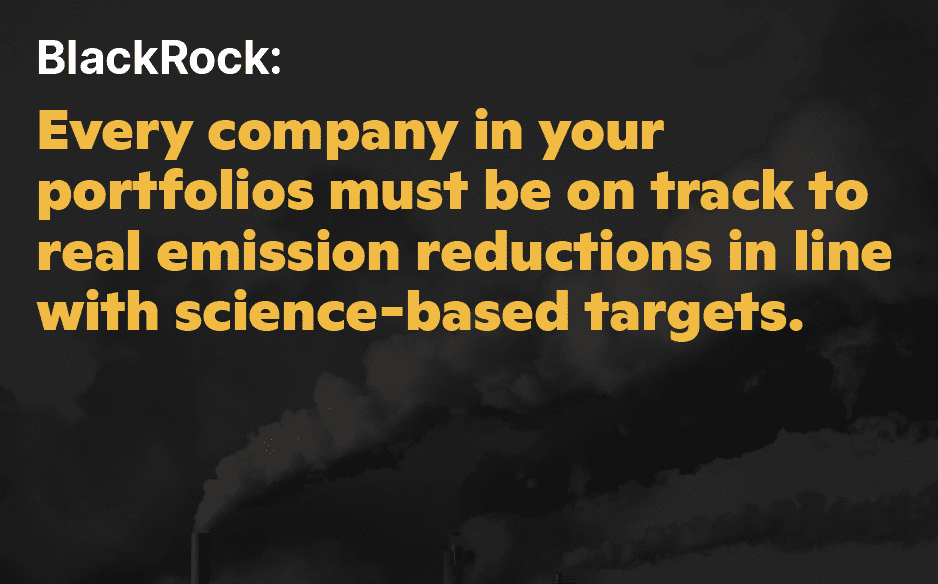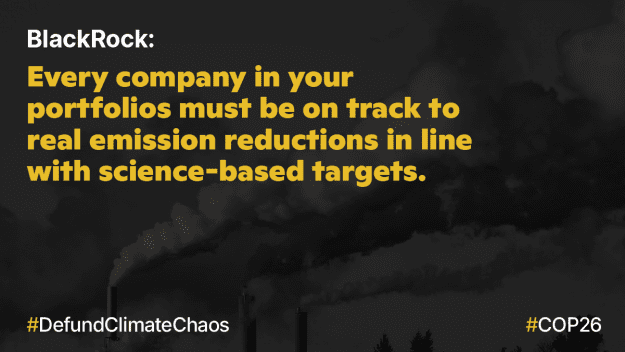By the end of the year, we anticipate BlackRock will release its interim target goal as part of its commitment to reach net zero by 2050. This interim target will represent the pace and ambition of BlackRock’s own efforts to decarbonize its portfolio by indicating what percentage of BlackRock’s overall assets under management will be net zero aligned by 2030.
Meaning, what percentage of companies in its portfolios a) have credible transition plans which lead to absolute emissions reductions in line with a 1.5°C pathway, b) are actively working on those plans, and c) are on track to hit the 2050 global target.

As is often the case with anything BlackRock does, this interim target carries an outsized impact, not only in what it represents for BlackRock’s own $9T business, but what it implies to the companies driving scope 1, 2, and 3 emissions worldwide and the financial community at large. BlackRock faces a choice. It can embody the swift, decisive action needed to reduce global emissions by half by 2030 and reach global net zero by 2050 by putting its targets in line with what the science says is necessary to increase our chances of limiting global warming to 1.5°C. Or BlackRock’s interim target will fall short, enabling business as usual that will likely blow us past the remaining carbon budget, making it almost impossible for the world to achieve net zero emissions by 2050.
Corporate commitments from financial institutions like BlackRock will not replace the need for assertive government action to drive decarbonization worldwide. However, as the larger climate community – from advocacy organizations, to investors, to industry leaders, to regulators – comes together to tackle this enormous crisis, financial institutions cannot be in the passenger seat. Only with a combination of government action and corporate directives can we initiate the system-wide shift necessary to stay on a 1.5°C pathway. BlackRock has had an enormous stake in the industries that have led to this crisis and now equally has an enormous stake in getting us on the right track. Success will not only require BlackRock’s participation, it will require its leadership and willingness to take initial, bold action.
The decision on Larry Fink’s desk is a big one. It is also a decision that will be measured against the high bar Larry Fink set for BlackRock in his 2020 letter to clients: “We believe that sustainability should be our new standard for investing.”
To that end, we are calling on BlackRock to make the commitment that by 2030, 100% of its AUM is on track to reach zero¹ emissions by mid-century or sooner. This is the climate leadership we need from Larry Fink and BlackRock.
1. Announce your interim target at COP
As the world gathers in Glasgow in early November, BlackRock should add its support and influence to drive the most ambitious climate agenda possible from government and corporate leaders. The success of this gathering depends on powerful leaders establishing the urgency and matching it with bold commitments. As the head of one of the largest financial institutions on the planet, Larry Fink has the influence and the responsibility to contribute to a meaningful outcome. He should use this global stage to set an aggressive and bold target which demonstrates that BlackRock is willing to lead in this space. Where BlackRock goes, others will follow.
Furthermore, BlackRock should use its membership in the Net Zero Asset Manager Initiative (NZAMI) to push for equally ambitious commitments from other signatories.
2. Leave no room for wishful thinking, loopholes, or exemptions
a. Set the expectation that 100% of companies must be onboard
Anything short of a 100% interim target from BlackRock leaves room for laggards to delay action, including the largest contributors to climate change (companies representing significant scope 1, 2, and 3 emissions). This would likely push us past our carbon budget for a 1.5°C pathway. BlackRock should therefore set the expectation for all companies, with special emphasis on heavy emitters, that their business must be on track to hit zero emissions (as we define it in this piece) by 2050 and in-line with 50% absolute emission reductions by 2030 if they want to be considered a part of BlackRock’s portfolio moving forward.
b. Prioritize the heaviest emitters
Many companies in BlackRock’s portfolio have limited or negligible climate impacts. These companies will easily hit absolute or near zero emissions well before 2050. The heaviest emitters, which will need to represent a limited and shrinking percentage of BlackRock’s overall portfolio, will be the hardest to change but pose the greatest threat to our ability to achieve absolute emissions reductions in-line with scientific targets. The priority sectors for aggressive and immediate action include coal², oil and gas³, utilities, auto manufacturers⁴ and other transportation industries, and steel.
A modest interim target goal from BlackRock which doesn’t explicitly prioritize and factor in these heavy emitters will contribute little to absolute emissions reductions by 2030. As part of the NZAMI, BlackRock has committed to set interim targets for 2030, consistent with a fair share of the 50% global reduction in CO2 identified as a requirement in the IPCC special report on global warming of 1.5°C. Achieving this goal will require that BlackRock prioritizes the carbon-heavy sectors and sets a high enough target that captures these polluting industries. A 100% target goal is the best way to send a clear and consistent signal that all companies, in particular heavy emitters, need to transition.

c. Redouble your efforts with investor initiatives and set hard consequences for no or substandard action
In the last year, BlackRock has increased its engagement with carbon-intensive industries and has indicated that, without sufficient progress, it will begin to take voting action (supporting shareholder resolutions or voting against directors) and consider limiting its exposure to or excluding the company from BlackRock’s active portfolios. BlackRock’s pledge to increase engagement has still left some critical questions unanswered, notably the deadline for engagement, deeper insight into what will constitute adequate and sufficient action on climate, and how that engagement will ratchet up over time to ensure that all companies are on track to meet emissions reduction targets in line with a 1.5°C pathway. It also raises the question how BlackRock will respond if a company has failed to produce or make progress on a viable transition plan after considerable engagement.
BlackRock’s recent moves to join broader investor initiatives like CA100+ and NZAMI is a welcome change from its previous “go it alone,” passive position on corporate engagement. These initiatives can bolster BlackRock’s own efforts to drive swift climate transitions within polluting industries. However, to maximize impact, BlackRock should push these initiatives even further by setting a standard and leading by example on the actions required to hold these industries accountable to viable, science-aligned, transition plans. This should include at minimum an immediate exclusion of all companies with coal expansion plans and rapid escalation at companies with proposed fossil fuel expansion plans.
BlackRock must also put more emphasis on engagement with the financial sector and other significant scope 3 emitters. In line with analysis from the recent IEA net zero report, banks and other financial companies must cease new fossil fuel financing. These financial institutions should actively wind down existing exposure and demonstrate transition plans consistent with a 1.5°C pathway. This applies not only to elements of BlackRock’s own business but should be the standard that BlackRock sets for the financial companies it is invested in.
3. Continue to tighten standards for companies on what “on track” means
a. Ensure that corporate net zero plans are actually on a 1.5°C pathway
As companies face growing investor and social pressure to adopt climate transition plans, heavy emitters, like most of the world’s oil and gas majors, have made climate pledges, but their transition plans fall far short of aligning with a 1.5°C pathway. The IEA has made it absolutely clear that there is no room for new fossil fuel expansion if we want to reach planetary net zero emissions by 2050. Companies continuing exploration and development of new fossil reserves are not compatible with a 1.5°C pathway target and need immediate intervention.
b. Follow science on % reduction targets
Companies will need to set concrete interim emission reduction targets. The urgent focus will need to be on the heaviest emitters. As highlighted in the UNEP Production Gap Report, fossil fuel production will have to decrease globally by roughly 6% per year between 2020 and 2030 to stay on a 1.5°C pathway. BlackRock should ensure that its interim target is aligned with this imperative and that all companies in or connected to the fossil fuel sector are covered accordingly. As a result, BlackRock should clearly state its expectations for these companies to be on track with what is required by climate science starting this year. Coal, oil and gas companies remaining in BlackRock’s portfolio need to commit to a swift reduction of fossil fuel production, with step-down targets aligned with a 1.5°C compatible trajectory, and an immediate end to new or expanding fossil fuel extraction projects. Utilities and auto manufacturers must also include step-down targets in line with coal and gas plant, and Internal Combustion Engine (ICE) phase-out dates that align with the IEA’s net zero roadmap.
c. Offsets cannot replace emission reductions
As detailed in recent analysis, nature-based offsets cannot offset fossil fuel combustion. Fossil fuel carbon emissions are permanent, nature-based offsets are not, as has become painfully evident in the increased frequency of wildfire, drought, and bio loss. The prominence and over-reliance on offsets are a nonsolution to the climate crisis, potentially threatening Indigenous and human rights and enabling heavy emitters to delay, ignore, or avoid absolute emissions reductions. Emissions removal technologies will likely be necessary given current CO2 concentrations but should in no way be allowed to offset continued or expanded emissions and should not be included in companies’ emission reduction targets.
- The concept of any one company achieving “net zero” emissions removed from the context of global emissions is counter-productive and opens the door for improbable carbon accounting and assumptions which enable continued emissions. Companies should aim to achieve “zero first”, meaning they should aim to reduce emissions to an absolute zero by 2050. And as an universal owner of the global economy, BlackRock plays a critical role in helping achieve a “planetary net zero” but the company must avoid the pitfalls around “net” highlighted in section three of this document.
- Limiting global warming to 1.5ºC will only be possible with a complete end to coal-fired power generation by 2030 in Europe and OECD countries and 2040 worldwide. According to the UNEP Production Gap Report, global coal production must decline by 11% annually from 2020 to 2030. It is thus urgent for BlackRock to adopt a more robust coal exit policy, in line with best practices, including a commitment to fully exit coal by 2030 in European and OECD countries and by 2040 globally.
- The IEA’s net zero pathway determines that gas for power must be mostly phased out by 2035 in OECD countries and 2040 in the rest of the world.
- The IEA’s net zero pathway also concludes an absolute end to Internal Combustion Engine (ICE) vehicle sales by 2035.

